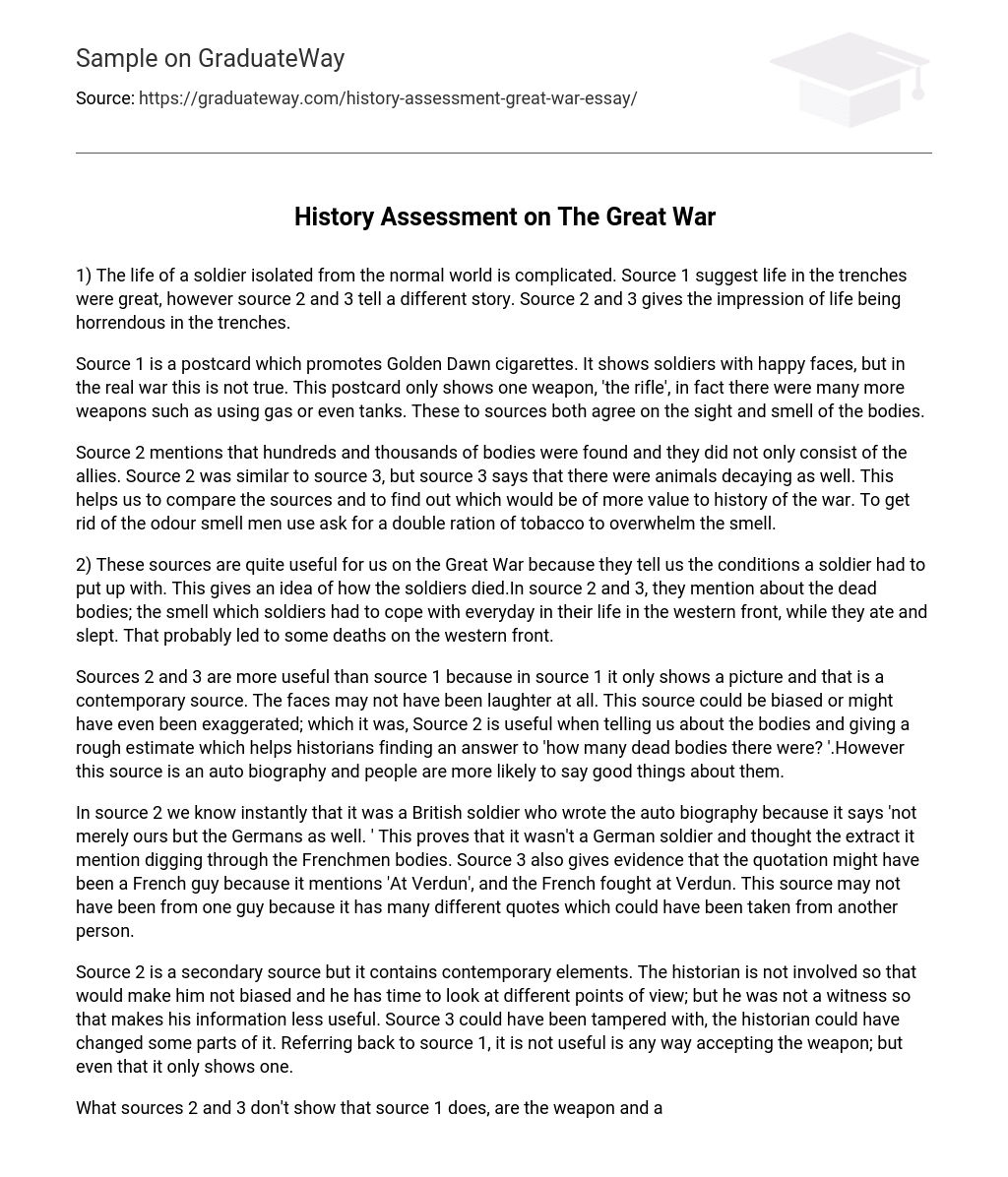1) The life of a soldier isolated from the normal world is complicated. Source 1 suggest life in the trenches were great, however source 2 and 3 tell a different story. Source 2 and 3 gives the impression of life being horrendous in the trenches.
Source 1 is a postcard which promotes Golden Dawn cigarettes. It shows soldiers with happy faces, but in the real war this is not true. This postcard only shows one weapon, ‘the rifle’, in fact there were many more weapons such as using gas or even tanks. These to sources both agree on the sight and smell of the bodies.
Source 2 mentions that hundreds and thousands of bodies were found and they did not only consist of the allies. Source 2 was similar to source 3, but source 3 says that there were animals decaying as well. This helps us to compare the sources and to find out which would be of more value to history of the war. To get rid of the odour smell men use ask for a double ration of tobacco to overwhelm the smell.
2) These sources are quite useful for us on the Great War because they tell us the conditions a soldier had to put up with. This gives an idea of how the soldiers died.In source 2 and 3, they mention about the dead bodies; the smell which soldiers had to cope with everyday in their life in the western front, while they ate and slept. That probably led to some deaths on the western front.
Sources 2 and 3 are more useful than source 1 because in source 1 it only shows a picture and that is a contemporary source. The faces may not have been laughter at all. This source could be biased or might have even been exaggerated; which it was, Source 2 is useful when telling us about the bodies and giving a rough estimate which helps historians finding an answer to ‘how many dead bodies there were? ‘.However this source is an auto biography and people are more likely to say good things about them.
In source 2 we know instantly that it was a British soldier who wrote the auto biography because it says ‘not merely ours but the Germans as well. ‘ This proves that it wasn’t a German soldier and thought the extract it mention digging through the Frenchmen bodies. Source 3 also gives evidence that the quotation might have been a French guy because it mentions ‘At Verdun’, and the French fought at Verdun. This source may not have been from one guy because it has many different quotes which could have been taken from another person.
Source 2 is a secondary source but it contains contemporary elements. The historian is not involved so that would make him not biased and he has time to look at different points of view; but he was not a witness so that makes his information less useful. Source 3 could have been tampered with, the historian could have changed some parts of it. Referring back to source 1, it is not useful is any way accepting the weapon; but even that it only shows one.
What sources 2 and 3 don’t show that source 1 does, are the weapon and a rough view of the soldiers’ uniform.Overall these sources are quite useful and you can get a lot of information about the living style in the trenches, but not about what they did in their spare time or the rations on food. 3) I think that source 1 is less reliable to an historian studying what life was like in the Great War because it gives false information. Obviously when you go to war, you wouldn’t be smiling and laughing at the time you are fighting; and on the postcard it shows that the soldiers were jolly lads.
I think they made the soldiers look happy either to reassure the soldiers’ wives that their husbands were okay, or just to promote Golden Dawn cigarettes.It doesn’t mention anything about a soldier’s lifestyle and how they coped with things like the decaying smell of bodies. It includes nothing about food like source 3 did about the tobacco, bread and the stale water. It only shows one weapon and not any other like Gas and tanks.
This source may be biased, so it is not trust worthy. I think the historian should study different sources and then come to a conclusion combining the sources together. 4) Although source 3 is not reliable to an historian it still is useful. It contains some information about soldiers and the trenches.
The postcard shows the soldiers quite deep in the trenches, this tells us that the trenches were quite deep and wide. Also it gives a rough outline of a soldier’s uniform, and on the picture you can just about see the soldier is carrying a bag, which is strapped around him; and in the bag there is a water bottle and some other stuff. It helps us know that soldiers were sending letters home because the soldier standing up is holding a letter in hid hand. It still shows one weapon the rifle.
Lastly we can see the floor is rocky and pebbly; so it must have been hard to dig in through tough ground.





